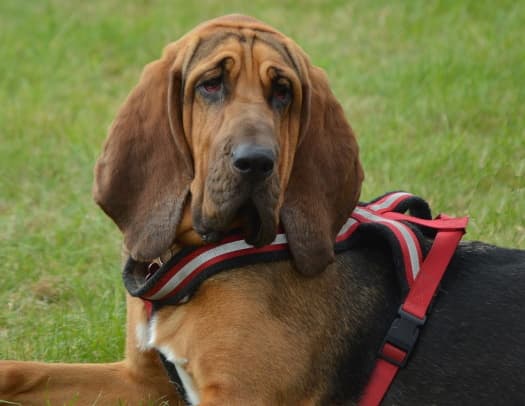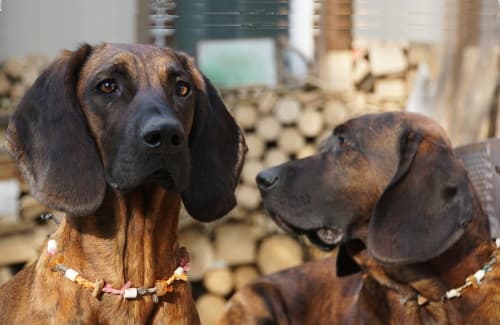The Bloodhound Dog
Follows a Trail Like No Other!
The Bloodhound dog can be traced back to ancient Rome and Greece according to credible sources on the breed. Later, around the 8th century, the
hounds were bred at a monastery on the border of France and Belgium and became know as the St. Hubert hound.

And so began the line that eventually arrived in England around the 11th century, along with the Norman invaders. Further selective breeding continued and subsequently, the breed became known as the Bloodhound (of pure blood).
This dog is easily recognizable by its deeply wrinkled face, long mouth and pendulous ears. His solemn expression fits
right in with the nature of his serious job assisting in detection work, as well as search and rescue.
However, in much earlier times his cold scenting abilities were used in
trailing wild boar and deer. When the prey was located, the hot
scenting pack hounds took over until the prey was brought down.
The excessive folds in the skin of the Bloodhound, are said to capture and direct the scent particles to his nose where his scenting receptors are in the millions!
Bloodhound Characteristics
The Bloodhound dog breed is mild mannered, has good disposition, is dignified and gentle. These are words that come to mind in describing this lovable dog.
Although his face has a sad look, underneath there is a friendly and affectionate hound that enjoys family life - he'd actually be a lap dog if it weren't for his size!
The Bloodhound can be more of a challenge to obedience train for an inexperienced owner. First time owners of the breed should be confident that they can provide strong leadership.
This should not be construed as harsh, but rather a firm yet fair approach to training, without compromise.
Drooling is a trait of the Bloodhound that must be considered before selecting this breed, especially if one is a meticulous housekeeper.
Second to that, is the fact that this is one big dog with a big appetite, so the food bill is going to be more significant.
 Hanoverian Bloodhounds
Hanoverian BloodhoundsHealth of the Bloodhound Dog Breed
With the benefit of good home care, a high quality diet, adequate exercise and regular health check-ups with a veterinarian, pet parents can expect to enjoy their Bloodhound for up to twelve years!
However, new and prospective owners should be aware that GVD or bloat as it is
commonly known, is a major cause of death in the Bloodhound.
This is a life-threatening emergency condition that requires immediate attention. But, we like to think that knowledge is power, or forewarned is forearmed. With that said, I recommend pet parents become fully informed about this condition here on the website so you'll not only know what to do should it occur, but also how you can help your dog avoid it.
Other significant health concerns include:
- Hip dysplasia: A genetic joint disease that results from the malformation of the hips and is characterized by joint weakness, stiffness, and pain caused. Depending on the severity of the condition, a veterinarian may advise pain medication or surgery.
- Elbow dysplasia: A common cause of front leg lameness. More specifically, an abnormal development of the elbow joint in young, large, rapidly growing dogs. Signs of elbow dysplasia appear in puppies 4 to 10 months of age.
- Osteochondritis: A common disease of growing large breed puppies caused by a defect in the calcification process of the cartilage.
- Patella Luxation aka Slipping Kneecap: As the name implies, this involves a dislocation of the kneecap to varying degrees and is usually an inherited defect and more common in toy or smaller breeds. Responsible breeders will screen more than one generation of parents for this condition, before breeding, as well as the resulting puppies, before they are offered for purchase. An early sign of Patella Luxation is limping.
It is also noted that the Bloodhound dog does have a higher than average amount of eye, ear and skin problems.
Health Tests Recommended By the National Breed Club:
- Hip Evaluation
- Elbow Evaluation
- Cardiac Exam
Appearance And Care
Height: 23-27 inches
Weight: Up to 110 lbs.
Color variations: Black and Tan, Tawny or Red and Tan
Coat and Care:
Rub down the dog's coat frequently with a hound glove to remove loose hair, and give a complete bath on an as-needed basis. A
circular motion works best on his thick short coat.
Like most dogs with long pendant ears, they need to be inspected and cleaned at least once a week to prevent infection. Facial folds should be wiped clean daily or even more often, especially around the mouth. The nails should be trimmed and kept short. Brush teeth daily or at least two to three times a week.
Activity Level
This dog is very strong and has lots of stamina. He needs to be taken out for a long walk each day at a minimum.
Having a secure place to run freely would a real plus.
Ideal Living Space
Surprisingly the Bloodhound can live in an apartment, providing he gets taken out and thoroughly exercised on a daily basis, but it's not the ideal.
A house
with large fenced yard where he has room to romp and run would be the best
situation.
The Bloodhound With Children?
Very good with children, in fact too good! The Bloodhound dog is so tolerant that they will put up with more than they should.
A great family dog for households with considerate and kindly youngsters.
Remember, the best policy is to always have an adult supervise when pets and children are interacting - no matter what the
breed's reputation.
Senior Or Less Active Families?
The exercise needs of the Bloodhound dog would not make it very suitable
for inactive seniors or any family that likes to be more sedentary.
Find a Bloodhound to Buy or Adopt
Once you've decided to welcome a Bloodhound into your home, the first step is to contact a reputable breeder. A breeder who is dedicated to the breed will generally be a member of the American Bloodhound Club and have signed its code of ethics.
On the other hand, casual breeders, along with pet shops and puppy mills, should be avoided because they are not concerned with upholding any standard - only about the breed's popularity and making sales.
Here are some places to begin your search:
- Available puppies and breeders can be found through the AKC Marketplace
- American Bloodhound Club provides referral to responsible breeders, as well as useful information to help you to find the right dog.
- American Bloodhound Rescue provides Rescue contacts
As part of your research, look for a dog show near you to connect with breeders and see adult hounds up close and talk with their owners. Maybe consider adopting an adult dog.
Before meeting a breeder prepare a list of questions so you remember what to ask. You can tell a lot about a reliable breeder by how willingly the health history of the parents is provided and if they encourage you to meet them. Dedicated breeders will also ask you a lot of questions about your experience with the Bloodhound and dogs in general.
Before You Go...
If you like the content of this page, as well as others on my site, please give it some love by clicking on the heart in the lower right hand corner. This helps me keep providing enjoyable and useful content.
Thank you.
Further Reading
First and foremost, those considering the breed are encouraged to read this book to make sure the Bloodhound - a very unique dog - is right for them.
It covers: finding your puppy plus everything an owner needs to know including detailed information regarding training, exercise, grooming, feeding, and a lot more. While it's a given that the Bloodhound has the ability to follow a scent, this book has advanced training on "Using Your Bloodhound’s Nose" - for nose work.
- Home ›
- AKC Breeds ›
- Bloodhound



